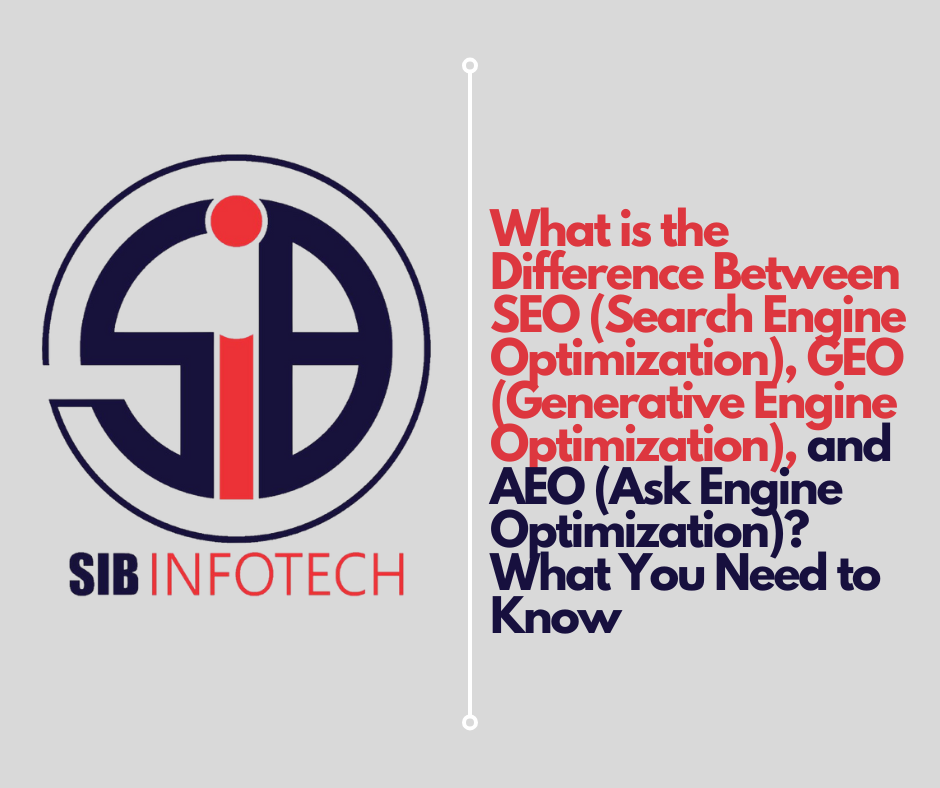Does the World of Digital Marketing Need Any More Three-Letter Acronyms?
In the ever-evolving landscape of digital marketing, new trends and technologies continuously shape the way businesses attract and retain customers. Just when we thought we had mastered SEO (Search Engine Optimization), the digital world introduced GEO (Generative Engine Optimization) and AEO (Ask Engine Optimization)—two game-changing concepts designed for the era of AI-driven searches.
But do we really need more three-letter acronyms in digital marketing? The answer is yes, and here’s why: As search behaviors evolve with AI-powered search engines, chatbots, and voice search, businesses must adapt to stay visible. Traditional SEO is no longer enough; understanding GEO and AEO is now crucial to maintaining online relevance.
So, let’s break down these three optimization strategies and explore how they impact digital marketing in today’s AI-driven world.
1. SEO (Search Engine Optimization): The Foundation of Digital Visibility
SEO has been the backbone of digital marketing for over two decades. It refers to the process of optimizing a website to rank higher in traditional search engines like Google, Bing, and Yahoo. The goal of SEO is to improve organic (non-paid) search rankings, thereby increasing website traffic and brand visibility.
Key Components of SEO
✅ On-Page SEO – Optimizing website content, keywords, title tags, meta descriptions, and internal links.
✅ Off-Page SEO – Building high-quality backlinks, social signals, and authority through external sources.
✅ Technical SEO – Enhancing website speed, mobile responsiveness, and structured data.
✅ Local SEO – Optimizing for Google My Business (GMB), location-based keywords, and local citations.
✅ Content SEO – Creating valuable, keyword-optimized content that attracts search engines and human readers.
Why SEO Still Matters
- It remains the best long-term strategy for ranking on Google.
- 93% of online experiences begin with a search engine.
- SEO generates higher ROI than paid advertising over time.
- It helps websites rank for high-intent keywords that drive qualified leads and conversions.
While SEO is still essential, search engines are changing. Google is no longer the sole decision-maker in digital discovery—AI-powered models are reshaping how people find information. That’s where GEO and AEO come into play.
2. GEO (Generative Engine Optimization): The Future of AI-Powered Search
GEO stands for Generative Engine Optimization, a new approach that focuses on optimizing content for AI-generated search results, particularly those created by ChatGPT, Google Bard, and other AI-driven assistants. Unlike traditional SEO, which targets ranking in search engine results pages (SERPs), GEO is about ensuring that AI models retrieve and present your brand’s information correctly and prominently.
Key Components of GEO
Optimizing for AI Chatbots – Ensuring AI models understand your brand, services, and expertise.
Structured Data & Knowledge Graphs – Feeding AI engines with accurate, machine-readable information.
Contextual Content – Writing factually correct, well-cited, and easily interpretable content for AI-based answers.
Conversational Queries – Adapting content for natural language processing (NLP), which AI uses to generate responses.
Why GEO Matters
- AI-driven search engines are replacing traditional keyword-based search queries.
- Google’s Search Generative Experience (SGE) and AI-powered responses prioritize fact-based, structured content over keyword-stuffed pages.
- Brand visibility depends on how well AI models understand your business.
Example: Instead of ranking as #1 in Google’s SERP, businesses now need to rank as the AI-generated answer to a query like,
“What is the best outdoor furniture brand in Malaysia?”
If AI models don’t recognize your brand, you’ll be invisible in AI-driven search results.
3. AEO (Ask Engine Optimization): The Age of Conversational Search
AEO, or Ask Engine Optimization, is a strategy designed to optimize content for voice search, AI assistants, and question-answering systems. Unlike traditional SEO, where users type keywords, AEO targets spoken and question-based queries.
Key Components of AEO
FAQ & Q&A Content – Structuring content in a way that answers common user questions directly.
Voice Search Optimization – Using conversational, natural language queries like “What is the difference between synthetic and natural rattan furniture?”
Featured Snippet Optimization – Securing the “Position Zero” spot in Google’s answer boxes.
Schema Markup & Entity-Based Search – Helping AI engines extract concise, fact-based answers.
Why AEO Matters
- Voice search is growing—by 2025, over 50% of searches will be voice-based.
- AI-powered assistants favor well-structured, direct answers over complex, keyword-heavy content.
- Google’s People Also Ask (PAA) and featured snippets prioritize AEO-friendly content.
Example:
Instead of searching “best patio furniture Malaysia”, users now ask AI assistants directly:
Keyword-based search: “Best patio furniture Malaysia”
AI-friendly query: “What are the most durable patio furniture options in Malaysia?”
If your content is optimized for AEO, AI assistants will pull information from your website as the best answer.
SEO vs. GEO vs. AEO: What’s the Difference?
| Feature | SEO (Search Engine Optimization) | GEO (Generative Engine Optimization) | AEO (Ask Engine Optimization) |
|---|---|---|---|
| Purpose | Rank in search engines like Google | Optimize for AI-generated answers | Optimize for voice and question-based searches |
| Best For | Websites, blogs, e-commerce | Businesses targeting AI-driven search | Voice search, conversational AI |
| Traffic Type | Organic search traffic | AI-driven search results | Voice search, AI chatbot responses |
| Ranking Goal | Google’s search engine results page (SERP) | AI models like ChatGPT, Google Bard | Voice assistants and direct Q&A search results |
Which Strategy Should Your Business Focus On?
✅ SEO is still the foundation of search visibility—every business needs it.
✅ GEO is essential for brands targeting AI-driven search engines.
✅ AEO is critical for businesses targeting voice search and AI assistants.
The Future: A Unified Digital Strategy
The best approach? Combine all three strategies:
✔️ Use SEO to rank in traditional search engines.
✔️ Adopt GEO to optimize content for AI-generated results.
✔️ Implement AEO to dominate voice search and AI-driven Q&A systems.
As AI search engines continue to evolve, businesses that fail to adapt will become invisible. The brands that thrive will be those that embrace SEO, GEO, and AEO as part of a unified digital marketing strategy.
Final Thoughts
The digital marketing landscape is shifting towards AI-powered discovery. While traditional SEO remains important, GEO and AEO are the future. If businesses want to maintain online relevance, they must optimize for AI-driven search engines, voice assistants, and conversational AI.
Are you ready for the future of search? Because AI isn’t waiting.
About the Author
Dr. Bilal Ahmad Bhat is a visionary entrepreneur and Founder of BAB Group of Companies. A pioneer in business development and digital strategy, he is dedicated to helping businesses grow in an AI-driven world.

